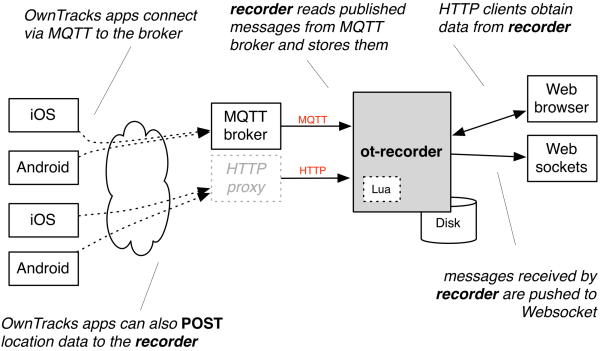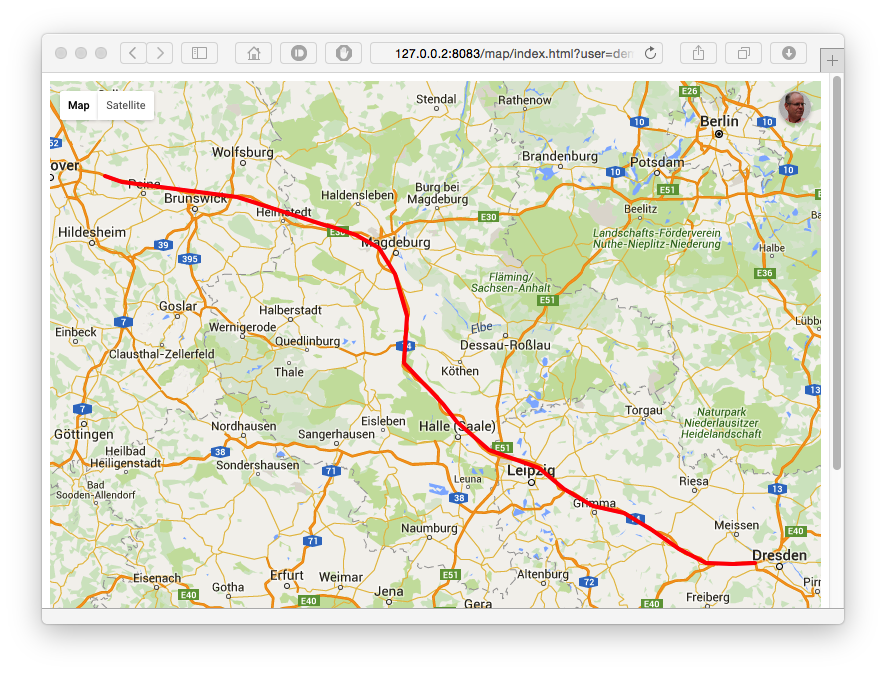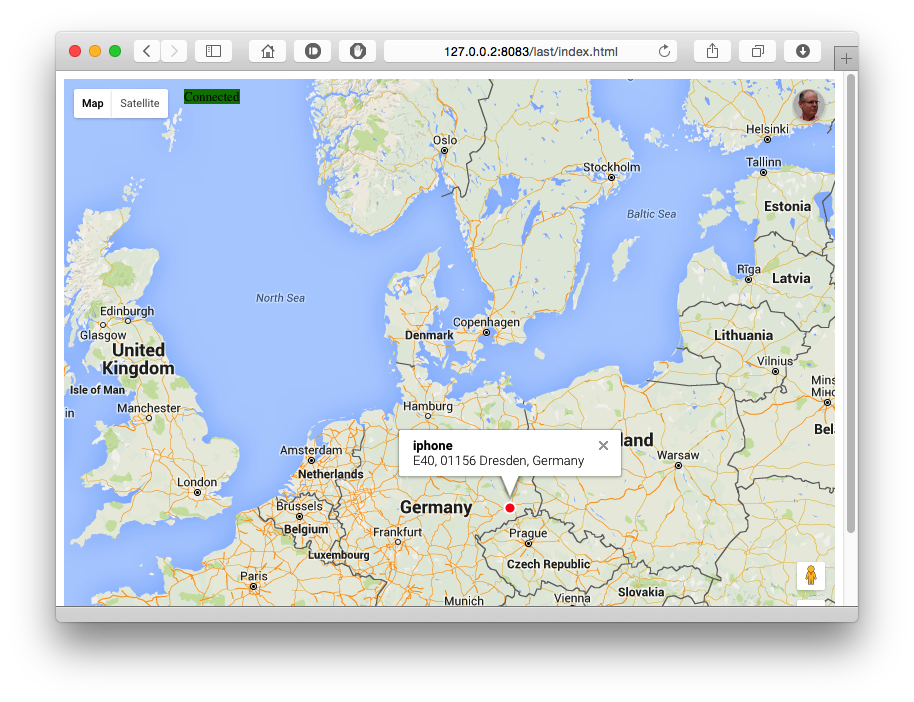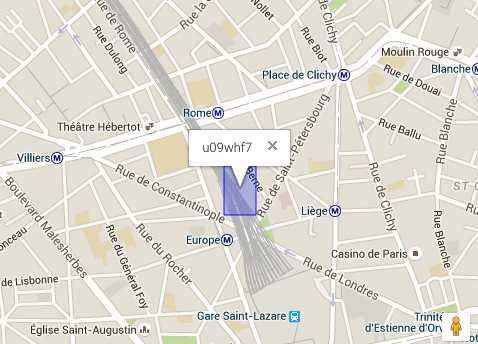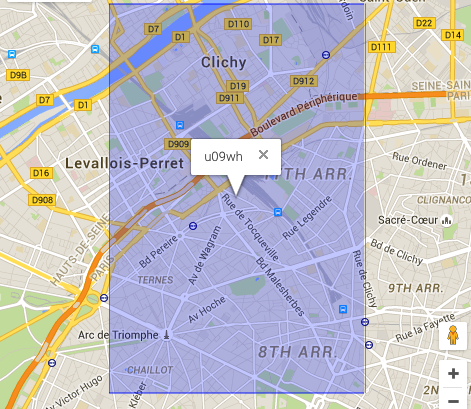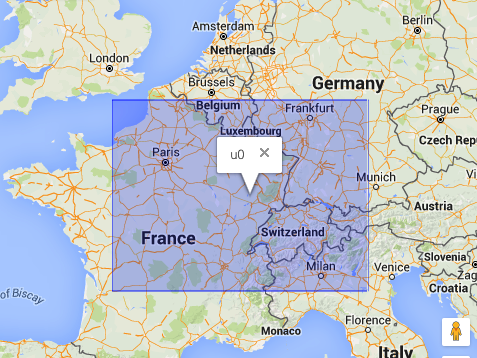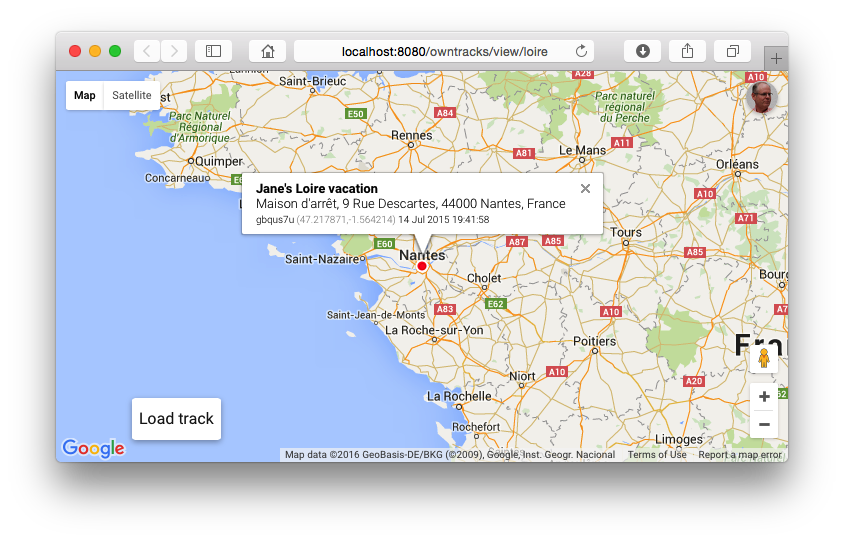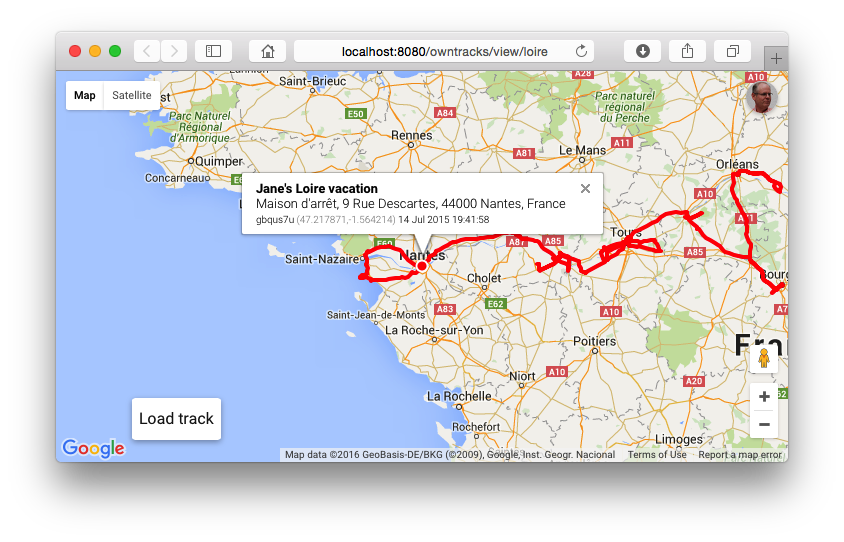56 KiB
OwnTracks Recorder
The OwnTracks Recorder is a lightweight program for storing and accessing location data published via MQTT (or HTTP) by the OwnTracks apps. It is a compiled program which is easily to install and operate even on low-end hardware, and it doesn't require external an external database.
There are two main components: the recorder obtains data via MQTT subscribes or HTTP POST, stores the data in plain files and serve it via its built-in REST API, and the ocat command-line utility reads stored data in a variety of formats.
We developed the recorder as a one-stop solution to storing location data published by our OwnTracks apps (iOS and Android) and retrieving this data. Our previous offerings (m2s, o2s/Pista) also work of course, but we believe the recorder is best suited to most environments.
recorder
The recorder serves two purposes:
- It subscribes to an MQTT broker and reads messages published from the OwnTracks apps, storing these in a particular fashion into what we call the store which is basically a bunch of plain files on the file system. Alternatively the Recorder can listen on HTTP for OwnTracks-type JSON messages POSTed to its HTTP server.
- It provides a Web server which serves static pages, a REST API you use to request data from the store, and a Websocket server. The distribution comes with a few examples of how to access the data through its HTTP interface (REST API). In particular a table of last locations has been made available as well as a live map which updates via the recorder's Websocket interface when location publishes are received. In addition we provide maps with last points or tracks using the GeoJSON produced by the recorder.
Installing
We provide a ready-to-run packages for a limited number of platforms on our package repository, and we provide a Docker image which bundles the Recorder and a Mosquitto broker directly from the Docker hub.
Building from source
You will require:
- libmosquitto unless you disable MQTT during building, but see below for platform instructions
- libCurl
- lmdb (included)
- libconfig
- Optionally Lua
- Optionally libsodium for secret-key encryption of payloads
- Obtain and download the software, via our Homebrew Tap on Mac OS X, directly as a clone of the repository, or as a tar ball which you unpack.
- Copy the included
config.mk.infile toconfig.mkand edit that. You specify the features or tweaks you need. (The file is commented.) Pay particular attention to the installation directory and the value of the store (STORAGEDEFAULT): that is where the recorder will store its files.DOCROOTis the root of the directory from which the recorder's HTTP server will serve files. - Type
makeand watch the fun.
When make finishes, you should have at least two executable programs called ot-recorder which is the recorder proper, and ocat. If you want you can install these using make install, but this is not necessary: the programs will run from whichever directory you like if you add --doc-root ./docroot to the recorder options.
Ensure the LMDB databases are initialized by running the following command which is safe to do, also after an upgrade. (This initialization is non-destructive -- it will not delete any data.)
ot-recorder --initialize
Unless already provided by the package you installed, we recommend you create a shell script with which you hence-force launch the recorder. Note that you can have it subscribe to multiple topics, and you can launch sundry instances of the recorder (e.g. for distinct brokers) as long as you ensure:
- that each instance uses a distinct
--storage - that each instance uses a distinct
--http-port(or0if you don't wish to provide HTTP support for a particular instance)
Getting started
The recorder has, like ocat, a daunting number of options, most of which you will not require. Running either utility with the -h or --help switch will summarize their meanings. You can, for example launch with a specific storage directory, disable the HTTP server, change its port, etc.
If you require authentication or TLS to connect to your MQTT broker, pay attention to the $OTR_ environment variables listed in the help.
Launch the recorder:
$ ./ot-recorder 'owntracks/#'
(In httpmode, you do not have to specify a topic.)
Publish a location from your OwnTracks app and you should see the recorder receive that on the console. If you haven't disabled Geo-lookups, you'll also see the address from which the publish originated.
The location message received by the recorder will be written to storage. In particular you should verify that your storage directory contains:
- a directory called
ghash/ - a directory called
rec/with several subdirectories and a.recfile therein. - a directory called
last/which contains subdirectories and a.jsonfile therein.
When the recorder has received a publish or two, visit it with your favorite Web browser by pointing your browser at http://127.0.0.1:8083 or the address / port configured with the --http-host and --http-port options respectively.
ot-recorder options and variables
This section lists the most important options of the recorder with their long names; check the usage (recorder -h) for the short versions.
--clientid specifies the MQTT client identifier to use upon connecting to the broker, thus overriding a constructed default.
--host is the name or address of the MQTT broker and overrides $OTR_HOST. The default is "localhost".
--port is the port number of the MQTT broker and overrides $OTR_PORT; it defaults to 1883. Setting this to 0 disables MQTT even if it is compiled-in.
--user overrides $OTR_USER and specifies the username to use in the MQTT connection.
$OTR_PASS is the password for the MQTT connection.
$OTR_CAFILE specifies the path to a readable PEM-formatted file containing the CA certificate chain to be used for the MQTT TLS connection. If this environment variable is set, a TLS connection is assumed (and the port number should probably be adjusted accordingly).
--qos specifies the MQTT QoS to use; it defaults to 2.
--storagedir is configured at build time and overrides $OTR_STORAGEDIR.
--useretained overrides the default of not consuming retained MQTT messages.
--norec disables writing of REC files, so no location history or other similar publishes are stored, and the Lua otr_putrec() function is not invoked even if it exists. What is stored are CARDS and PHOTOS, as well as the LAST location of a device. As such, the API's /locations endpoint becomes useless.
--norevgeo suppresses reverse geo lookups, but this means that historic data will not show addresses (e.g. with the API or with ocat). See below for information on Reverse Geo lookups.
--logfacility is the syslog facility to use (default is LOCAL0).
--quiet disables printing of messages to stdout.
--initialize creates the a structure within the storage directory and initializes the LMDB database. It is safe to use this even if such a database exists -- the database is not wiped. After initialization, recorder exits.
--label specifies a label (default: "Recorder") to be shown in the websocket live map.
--http-host and --http-port define the listen address and port number for the API. If --http-port is 0, the Web server is disabled.
--docroot overrides the compile-time setting of the HTTP document root.
--lua-script specifies the path to the Lua script. If not given, Lua support is disabled.
--precision overrides the compiled-in default. (See "Precision" later.)
--geokey sets the Google API key for reverse geo lookups. If you do more than 2500 (currently) reverse-geo requests per day, you'll need an API key for Google's geocoding service. Specify that here.
--debug enables a bit of additional debugging on stderr.
The HTTP server
Some examples of what the recorder's built-in HTTP server is capable of, in addition to obtaining OwnTracks app data via HTTP POST to the /pub endpoint.
Last position of a particular user
Retrieve the last position of a particular user. In addition to the values obtained in the location publish from the OwnTracks device, there are a few which we return as convenience:
usernamecontains the name of the user obtained from the publish topicdevicecontains the user's device name as obtained from the publish topictopicis the full topic to which the payload was publishedghashis the geohash string which corresponds tolatandlonisotstis the ISO timestamp of the publish time (tst)disptstis the same but designed for displayingccis the country code of the location point if available in the cache (see below)addris the address of the location point if available in the cache
$ curl http://127.0.0.2:8083/api/0/last -d user=demo -d device=iphone
[
{
"tst": 1440405601,
"acc": 10,
"_type": "location",
"alt": 262,
"lon": 13.60279820860699,
"vac": 6,
"vel": 18,
"lat": 51.06263391678321,
"cog": 82,
"tid": "NE",
"batt": 99,
"username": "demo",
"device": "iphone",
"topic": "owntracks/demo/iphone",
"ghash": "u31dmx9",
"isotst": "2015-08-24T08:40:01Z",
"disptst": "2015-08-24 08:40:01",
"cc": "DE",
"addr": "E40, 01156 Dresden, Germany"
}
]
Display map with points starting at a particular date
By specifying a format we can produce GeoJSON, say. Normally, the API retrieves the last 6 hours of data but we can extend or limit this with the from and to parameters.
http://127.0.0.2:8083/map/index.html?user=demo&device=iphone&format=geojson&from=2014-01-01
In a suitable Web browser, the result is
Display a track (a.k.a linestring)
If we change the format parameter of the previous URL to linestring, the result is
Tabular display
The recorder's Web server also provides a tabular display which shows the last position of devices, their address, country, etc. Some of the columns are sortable, you can search for users/devices and click on the address to have a map opened at the device's last location.
Live map
The recorder's built-in Websocket server updates a map as it receives publishes from the OwnTracks devices. Here's an example:
ocat
ocat is a CLI query program for data stored by recorder: it prints data from storage in a variety of output formats:
- JSON
- GeoJSON (points)
- GeoJSON (line string)
- CSV
- GPX
- XML
- raw (the lines contained in the REC file with ISO timestamp)
- payload (basically just the payload part from RAW)
The ocat utility accesses storage directly — it doesn’t use the recorder’s REST interface. ocat has a daunting number of options, some combinations of which make no sense at all.
Some example uses we consider useful:
ocat --listshow which uers are in storage.ocat --list --user jjolieshow devices for the specified userocat --user jjolie --device ipadprint JSON data for the user's device produced during the last 6 hours.ocat --lastprint the LAST position of all users, devices. Can be combined with--userand--device.ocat ... --format csvproduces CSV. Limit the fields you want extracted with--fields lat,lon,ccfor example.ocat ... --format xmlproduces XML. Limit the fields you want extracted with--fields lat,lon,ccfor example.
<?xml version='1.0' encoding='UTF-8'?>
<?xml-stylesheet type='text/xsl' href='owntracks.xsl'?>
<owntracks>
<point>
<tst>1440405601</tst>
<acc>10.000000</acc>
<alt>262</alt>
<lon>13.602798</lon>
<vac>6.000000</vac>
<vel>18</vel>
<lat>51.062634</lat>
<cog>82</cog>
<tid>NE</tid>
<batt>99</batt>
<username>demo</username>
<device>iphone</device>
<topic>owntracks/demo/iphone</topic>
<ghash>u31dmx9</ghash>
<isotst>2015-08-24T08:40:01Z</isotst>
<disptst>2015-08-24 08:40:01</disptst>
<cc>DE</cc>
<addr>E40, 01156 Dresden, Germany</addr>
</point>
</owntracks>
ocat ... --limit 10prints data for the current month, starting now and going backwards; only 10 locations will be printed. Generally, the--limitoption reads the storage back to front which makes no sense in some combinations.
Specifying --fields lat,tid,lon will request just those JSON elements from storage. (Note that doing so with output GPX or GEOJSON could render those formats useless if, say, lat is missing in the list of fields.)
The --from and --to options allow you to specify a UTC date and/or timestamp from which respectively until which data will be read. By default, the last 6 hours of data are produced. If --from is not specified, it therefore defaults to now minus 6 hours. If --to is not specified it defaults to now. Dates and times must be specified as strings, and the following formats are recognized:
%Y-%m-%dT%H:%M:%S
%Y-%m-%dT%H:%M
%Y-%m-%dT%H
%Y-%m-%d
%Y-%m
The --limit option limits the output to the last specified number of records. This is a bit of an "expensive" operation because we search the .rec files backwards (i.e. from end to beginning). When using --limit the 6 hours mentioned earlier do not apply.
ocat examples
The recorder has been running for a while, and the OwnTracks apps have published data. Let us have a look at some of this data.
List users and devices
We obtain a list of users from the store:
$ ocat --list
{
"results": [
"demo"
]
}
From which devices has user demo published data?
$ ocat --list --user demo
{
"results": [
"iphone"
]
}
Show the last position reported by a user
Where was demo's iphone last seen? (Omit --user and --device to get LAST for all users and devices.)
$ ocat --last --user demo --device iphone
[
{
"tst": 1440405601,
"acc": 10,
"_type": "location",
"alt": 262,
"lon": 13.60279820860699,
"vac": 6,
"vel": 18,
"lat": 51.06263391678321,
"cog": 82,
"tid": "NE",
"batt": 99,
"username": "demo",
"device": "iphone",
"topic": "owntracks/demo/iphone",
"ghash": "u31dmx9",
"isotst": "2015-08-24T08:40:01Z",
"disptst": "2015-08-24 08:40:01",
"cc": "DE",
"addr": "E40, 01156 Dresden, Germany"
}
]
Several things worth mentioning:
- The returned data structure is an array of JSON objects; had we omitted specifying a particular device or even a particular user we would have obtained the last position of all this user's devices or all users' devices respectively.
- If you are familiar with the JSON data reported by the OwnTracks apps you'll notice that this JSON contains more information: this is provided on the fly by ocat and the REST API, e.g. from the reverse-geo cache the recorder maintains.
What were the last 4 positions reported?
We can limit the number of returned elements: Let's do this as CSV, and limit the fields we are given:
$ ocat --user demo --device iphone --limit 4 --format csv --fields isotst,vel,addr
isotst,vel,addr
2015-08-24T08:40:01Z,18,"E40, 01156 Dresden, Germany"
2015-08-24T08:35:01Z,40,"E40, 01723 Wilsdruff, Germany"
2015-08-24T08:30:00Z,50,"A14, 01683 Nossen, Germany"
2015-08-24T08:24:59Z,40,"A14, 04741 Roßwein, Germany"
Design decisions
We took a number of decisions when designing the recorder and its utilities:
- Flat files. The filesystem is the database. Period. That's were everything is stored. It makes incremental backups, purging old data, manipulation via the Unix toolset easy. (Admittedly, for fast geo-lookups we employ LMDB as a cache, but the final word is in the filesystem.) We considered all manner of databases and decided to keep this as simple and lightweight as possible. You can however have the recorder send data to a database of your choosing, in addition to the file system it uses, by utilizing our embedded Lua hook.
- We wanted to store received data in the format it's published in. As this format is JSON, we store this raw payload in the
.recfiles. If we add an attribute to the JSON published by our apps, you have it right there. There's one slight exception: the monthly logs (the.recfiles) have a leading timestamp and a relative topic; see below. (In the particular case of the OwnTracks firmware for Greenwich devices which can publish in CSV mode, we convert the CSV into OwnTracks JSON for storage.) - File names are lower case. A user called
JaNewith a device namedmyPHONewill be found in a file namedjane/myphone. - All times are UTC (a.k.a. Zulu or GMT). We got sick and tired of converting stuff back and forth. It is up to the consumer of the data to convert to localtime if need be.
- The recorder does not provide authentication or authorization. Nothing at all. Zilch. Nada. Think about this before making it available on a publicly-accessible IP address. Or rather: don't think about it; just don't do it. You can of course place a HTTP proxy in front of the
recorderto control access to it. Or use views (see below). ocat, the cat program for the recorder uses the same back-end which is used by the API though it accesses it directly (i.e. without resorting to HTTP).- The recorder supports 3-level MQTT topics only, in the typical OwnTracks format:
"owntracks/<username>/<devicename>", optionally with a leading slash. (The first part of the topic need not be "owntracks".) Publishes via HTTP POST construct a ficticious topic internally using the provided user (u) and device (d) parameters.
Storage
As mentioned earlier, data is stored in files, and these files are relative to STORAGEDIR (compiled into the programs or specified as an option). In particular, the following directory structure can exist, whereby directories are created as needed by the recorder:
cards/, optional, may contains user cards. This card is then stored here and used with, e.g.,ocat --lastto show a user's name and optional avatar. User cards are typically stored in a subdirectory called username, and therein a JSON file username.json. When reading cards, the recorder will first attempt to open username/device/username.json and then username/username.json.config/, optional, contains the JSON of a device configuration (.otrc) which was requested remotely via a dump command. Note that this will contain sensitive data. You can use this.otrcfile to restore the OwnTracks configuration on your device by copying to the device and opening it in OwnTracks.ghash/, unless disabled, reverse Geo data (using a Google service) is collected into an LMDB database located in this directory. This LMDB database also contains named databases which are used by your optional Lua hooks, as well as atopic2tiddatabase which can be used for TID re-mapping.last/contains the last location published by devices. E.g. Jane's last publish from her iPhone would be inlast/jjolie/iphone/jjolie-iphone.json. The JSON payload contained therein is enhanced with the fieldsuser,device,topic, andghash. If a device'slast/directory contains a file calledextra.json(i.e. matching the example, this would belast/jjolie/iphone/extra.json), the content of this file is merged into the existing JSON for this user and returned by the API. Note, that you cannot overwrite existing values. So, anextra.jsoncontaining{ "tst" : 11 }will do nothing because thetstelement we obtain from location data overrules, but adding{ "beverage" : "water" }will do what you want. If recorder is built with support for our Greenwich firmware, this directory might containbatt.json,ext.json, and/orstatus.jsoneach of which hold an array of the last 100 reports for internal battery voltage, external voltage, and status respectively. These values are returned via the API in the LAST object. A filehttp.jsonwhich should contain either a single JSON object or an array of JSON objects is returned to clients in HTTPmode.monitora file which contains a timestamp and the last received topic (see Monitoring below).msg/contains messages received by the Messaging system.photos/optional; contains the binary photos from a card.rec/the recorder data proper. One subdirectory per user, one subdirectory therein per device. Data files are namedYYYY-MM.rec(e.g.2015-08.recfor the data accumulated during the month of August 2015.waypoints/contains a directory per user and device. Therein are individual files named by a timestamp with the JSON payload of published (i.e. shared) waypoints. The file names are timestamps because thetstof a waypoint is its key. If a user publishes all waypoints from a device (Publish Waypoints), the payload is stored in this directory asusername-device.otrw. (Note, that this is the JSON waypoints import format.) You can use this.otrwfile to restore the waypoints on your device by copying to the device and opening it in OwnTracks.
You should definitely not modify or touch these files: they remain under the control of the recorder. You can of course, remove old .rec files if they consume too much space.
Configuration file
The recorder attempts to read its startup configuration from a configuration file; the path to this is compiled into the Recorder (typically /etc/defaults/ot-recorder, and ocat -v will display the compiled-in default). The format of this file approximates that of a shell script with variables to be exported (the intention is so that it can be sourced by a shell script). Lines beginning with an octothorp (#) are ignored as are blank lines. Configuration settings proper are set as follows (note that some older versions of libconfig require a trailing semicolon (;) at the end of a variable assignment):
OTR_STORAGEDIR="/var/spool/owntracks/recorder/store"
The following configuration settings may be applied (a Y in column $ means an environment variable of the same name overrides a setting in the config file):
| Variable | $ | Default | Usage |
|---|---|---|---|
OTR_STORAGEDIR |
Y | compiled in | Pathname to the storage directory |
OTR_HOST |
Y | localhost |
MQTT hostname/address to connect to |
OTR_PORT |
Y | 1883 |
MQTT port number to connect to |
OTR_USER |
Y | MQTT username | |
OTR_PASS |
Y | MQTT password | |
OTR_QOS |
2 |
MQTT QoS | |
OTR_CLIENTID |
hostname+pid | MQTT ClientID (override with -i) | |
OTR_HTTPHOST |
localhost |
Address for the HTTP module to bind to | |
OTR_HTTPPORT |
8083 |
Port number of the HTTP module to bind to | |
OTR_HTTPLOGDIR |
Directory in which to store access.log. Override with --http-logdir | ||
OTR_LUASCRIPT |
Path to the Lua script | ||
OTR_PRECISION |
7 |
Reverse-geo precision | |
OTR_GEOKEY |
API key for reverse-geo lookups | ||
OTR_TOPICS |
String containing a space-separated list of topics to subscribe to for MQTT (overriden by command-line arguments) | ||
OTR_CAFILE |
Y | Path to PEM-encoded CA certificate file for MQTT |
Note that options passed to ot-recorder override both configuration file settings and environment variables.
Reverse Geo
If not disabled with option --norevgeo, the recorder will attempt to perform a reverse-geo lookup on the location coordinates it obtains and store them in an LMDB database. If a lookup is not possible, for example because you're over quota, the service isn't available, etc., recorder keeps tracks of the coordinates which could not be resolved in a file named missing:
$ cat store/ghash/missing
u0tfsr3 48.292223 8.274535
u0m97hc 46.652733 7.868803
...
This can be used to subsequently obtain missed lookups.
We recommend you keep reverse-geo lookups enabled, this data (country code cc, and the locations address addr) is used by the example Web apps provided by the recorder to show where a particular device is. In addition, this cached data is used the the API (also ocat) when printing location data.
Precision
The precision with which reverse-geo lookups are performed is controlled with the --precison option to recorder (and with the --precision option to ocat when you query for data). The default precision is compiled into the code (from config.mk). The higher the number, the more frequently lookups are performed; conversely, the lower the number, the fewer lookups are performed. For example, a precision of 1 means that points within an area of approximately 5000 km^2 would resolve to a single address, whereas a precision of 7 means that points within an area of approximately 150 m^2 resolve to one address. The recorder obtains a location publish, extracts the latitude and longitude, and then calculates the geohash string and truncates it to precision. If the calculated geohash string can be found in our local LMDB cache, we consider the point cached; otherwise an actual reverse geo lookup (via HTTP) is performed and the result is cached in LMDB at the key of the geohash.
As an example, let's assume Jane's device is at position (lat, lon) 48.879840, 2.323522, which resolves to a geohash string of length 7 u09whf7. We can visualize this and show what this looks like. (See also: visualizing geohash.)
Every location publish outside that very small blue square would mean another lookup. If, however, we lower the precision to, say, 5, a much larger area is covered
and a precision of 2 would mean that a very large part of France resolves to a single address:
The bottom line: if you run the recorder with just a few devices and want to know quite exactly where you've been, use a high precision (7 is probably good). If you, on the other hand, run recorder with many devices and are only interested in where a device was approximately, lower the precision; this also has the effect that fewer reverse-geo lookups will be performed in the Google infrastructure. (Also: respect their quotas!)
The geo cache
As hinted to above, the address data obtained through a reverse-geo lookup is stored in an embedded LMDB database, the content of which we can look at with
$ ocat --dump
u09whf7 {"cc":"FR","addr":"1 Rue de Saint-Pétersbourg, 75008 Paris, France","tst":1445435622,"locality":"Paris"}
u09ey1r {"cc":"FR","addr":"D83, 91590 La Ferté-Alais, France","tst":1445435679,"locality":"La Ferté-Alais"}
The key to this data is the geohash string (here with an example of precision 2).
Monitoring
In order to monitor the recorder, whenever an MQTT message is received, a monitor file located relative to STORAGEDEFAULT is maintained. It contains a single line of text: the epoch timestamp and the last received topic separated from each other by a space.
1439738692 owntracks/jjolie/ipad
If recorder is built with WITH_PING (default), a location publish to owntracks/ping/ping (i.e. username is ping and device is ping) can be used to round-trip-test the recorder. For this particular username/device combination, recorder will store LAST position, but it will not keep a .REC file for it. This can be used to verify, say, via your favorite monitoring system, that the recorder is still operational.
After sending a pingping, you can query the REST interface to determine the difference in time. The contrib/ directory has an example Python program (ot-ping.py) which you can adapt as needed for use by Icinga or Nagios.
OK ot-recorder pingping at http://127.0.0.1:8085: 0 seconds difference
HTTP server
The recorder has a built-in HTTP server with which it servers static files from either the compiled-in default DOCROOT directory or that specified at run-time with the --doc-root option. Furthermore, it serves JSON data from the API end-point at /api/0/ and it has a built-in Websocket server for the live map.
The API basically serves the same data as ocat is able to produce.
API
The recorder's API provides most of the functions that are surfaced by ocat. GET and POST requests are supported, and if a username and device are needed, these can be passed in via X-Limit-User and X-Limit-Device headers alternatively to GET or POST parameters. (From and To dates may also be specified as X-Limit-From and X-Limit-To
respectively.)
The API endpoint is at /api/0 and is followed by the verb.
monitor
Returns the content of the monitor file as plain text.
curl 'http://127.0.0.1:8083/api/0/monitor'
1441962082 owntracks/jjolie/phone
last
Returns a list of last users' positions. (Can be limited by user, device, and fields, a comma-separated list of fields which should be returned instead of the default of all fields.)
curl http://127.0.0.1:8083/api/0/last [-d user=jjolie [-d device=phone]]
curl 'http://127.0.0.1:8083/api/0/last?fields=tst,tid,addr,topic,isotst'
list
List users. If user is specified, lists that user's devices. If both user and device are specified, lists that device's .rec files.
locations
Here comes the actual data. This lists users' locations and requires both user and device. Output format is JSON unless a different format is given (csv, json, geojson, xml, and linestring are supported).
In order to limit the number of records returned, use limit which causes a reverse search through the .rec files; this can be used to find the last N positions.
Date/time ranges may be specified as from and to with dates/times specified as described for ocat above.
curl http://127.0.0.1:8083/api/0/locations -d user=jpm -d device=5s
curl http://127.0.0.1:8083/api/0/locations -d user=jpm -d device=5s -d limit=1
curl http://127.0.0.1:8083/api/0/locations -d user=jpm -d device=5s -d format=geojson
curl http://127.0.0.1:8083/api/0/locations -d user=jpm -d device=5s -d from=2014-08-03
curl 'http://127.0.0.1:8083/api/0/locations?from=2015-09-01&user=jpm&device=5s&fields=tst,tid,addr,isotst'
q
Query the geo cache for a particular lat and lon.
curl 'http://127.0.0.1:8083/api/0/q?lat=48.85833&lon=2.295'
{
"cc": "FR",
"addr": "9 Avenue Anatole France, 75007 Paris, France",
"tst": 1441984405
}
The reported timestamp was the time at which this cache entry was made. Note that this interface queries only -- it does not populate the cache.
photo
Requires GET method and user, and will return the image/png 40x40px photograph of a user if available in STORAGEDIR/photos/ or a transparent 40x40png with a black border otherwise.
kill
If support for this is compiled in, this API endpoint allows a client to remove data from storage. (Warning: any client can do this, as there is no authentication/authorization in the recorder!)
curl 'http://127.0.0.1:8083/api/0/kill?user=ngin&device=ojo'
{
"path": "s0/rec/ngin/ojo",
"status": "OK",
"last": "s0/last/ngin/ojo/ngin-ojo.json",
"killed": [
"2015-09.rec",
]
}
The response contains a list of removed .rec files, and file system operations are logged to syslog.
version
Returns a JSON object which contains the Recorder's version string, such as
{ "version": "0.4.7" }
Lua hooks
If recorder is compiled with Lua support, a Lua script you provide is launched at startup. Lua is a powerful, fast, lightweight, embeddable scripting language. You can use this to process location publishes in any way you desire: your imagination (and Lua-scripting knowhow) set the limits. Some examples:
- insert publishes into a database of your choice
- switch on the coffee machine when your OwnTracks device reports you're entering home (but see also mqttwarn)
- write a file with data in a format of your choice (see
etc/example.lua)
Run the recorder with the path to your Lua script specified in its --lua-script option (there is no default). If the script cannot be loaded (e.g. because it cannot be read or contains syntax errors), the recorder unloads Lua and continues without your script.
If the Lua script can be loaded, it is automatically provided with a table variable called otr which contains the following members:
otr.versionis a read-only string with the recorder version (example:"0.3.2")otr.log(s)is a function which takes a stringswhich is logged to syslog at the recorder's facility and log level INFO.otr.strftime(fmt, t)is a function which takes a format stringfmt(seestrftime(3)) and an integer number of secondstand returns a string with the formatted UTC time. Iftis 0 or negative, the current system time is used.otr.putdb(key, value)is a function which takes two stringskandvand stores them in the named LMDB database calledluadb. This can be viewed withotr.getdb(key)is a function which takes a single stringkeyand returns the database value associated with that key ornilif the key isn't stored.
ocat --dump=luadb
Your Lua script must provide the following functions:
otr_init
This is invoked at start of recorder. If the function returns a non-zero value, recorder unloads Lua and disables its processing; i.e. the hook() will not be invoked on location publishes.
otr_exit
This is invoked when the recorder stops, which it doesn't really do unless you CTRL-C it or send it a SIGTERM signal.
otr_hook
This function is invoked at every location publish processed by the recorder. Your function is passed three arguments:
- topic is the topic published to (e.g.
owntracks/jane/phone) - type is the type of MQTT message. This is the
_typein our JSON messages (e.g.location,cmd,transition, ...) or"unknown". - location is a Lua table (associative array) with all the elements obtained in the JSON message. In the case of type being
location, we also add country code (cc) and the location's address (addr) unless reverse-geo lookups have been disabled in recorder.
Assume the following small example Lua script in example.lua:
local file
function otr_init()
otr.log("example.lua starting; writing to /tmp/lua.out")
file = io.open("/tmp/lua.out", "a")
file:write("written by OwnTracks Recorder version " .. otr.version .. "\n")
end
function otr_hook(topic, _type, data)
local timestr = otr.strftime("It is %T in the year %Y", 0)
print("L: " .. topic .. " -> " .. _type)
file:write(timestr .. " " .. topic .. " lat=" .. data['lat'] .. data['addr'] .. "\n")
end
function otr_exit()
end
When recorder is launched with --lua-script example.lua it invokes otr_init() which opens a file. Then, for each location received, it calls otr_hook() which updates the file.
Assuming an OwnTracks device publishes this payload
{"cog":-1,"batt":-1,"lon":2.29513,"acc":5,"vel":-1,"vac":-1,"lat":48.85833,"t":"u","tst":1441984413,"alt":0,"_type":"location","tid":"JJ"}
the file /tmp/lua.out would contain
written by OwnTracks Recorder version 0.3.0
It is 14:10:01 in the year 2015 owntracks/jane/phone lat=48.858339 Avenue Anatole France, 75007 Paris, France
otr_putrec
An optional function you provide is called otr_putrec(u, d, s). If it exists,
it is called with the current user in u, the device in d and the payload
(which for OwnTracks apps is JSON but for, eg Greenwich devices might not be) in the string s. If your function returns a
non-zero value, the recorder will not write the REC file for this publish.
otr_httpobject
An optional function you provide is called otr_httpobject(u, d, t, data) where u is the username used by the client (?u=), d is the device name (&d= in the URI), t is the OwnTracks JSON _type and data a Lua table built from the OwnTracks JSON payload of _type. If it exists, this function is called whenever a POST is received in httpmode and the Recorder is gathering data to return to the client app. The function must return a Lua table containing any number of string, number, or boolean values which are converted to a JSON object and appended to the JSON array returned to the client. An example shows how, say, a transition event can be used to open the Featured content tab in the app.
Hooklets
After running otr_hook(), the recorder attempts to invoke a Lua function for each of the elements in the extended JSON. If, say, your Lua script contains a function called hooklet_lat, it will be invoked every time a lat is received as part of the JSON payload. Similarly with hooklet_addr, hooklet_cc, hooklet_tst, etc. These hooklets are invoked with the same parameters as otr_hook().
You define a hooklet function only if you're interested in expressly triggering on a particular JSON element.
Environment
The following environment variables control ocat's behaviour:
OCAT_FORMATcan be set to the preferred output format. If unset, JSON is used. The--formatoption overrides this setting.OCAT_USERNAMEcan be set to the preferred username. The--useroption overrides this environment variable.OCAT_DEVICEcan be set to the preferred device name. The--deviceoption overrides this environment variable.
nginx
Running the recorder protected by an nginx or Apache server is possible and is the only recommended method if you want to server data behind localhost. This snippet shows how to do it, but you would also add authentication to that.
server {
listen 8080;
server_name 192.168.1.130;
location / {
root html;
index index.html index.htm;
}
# Proxy and upgrade Websocket connection
location /otr/ws {
rewrite ^/otr/(.*) /$1 break;
proxy_pass http://127.0.0.1:8084;
proxy_http_version 1.1;
proxy_set_header Upgrade $http_upgrade;
proxy_set_header Connection "upgrade";
proxy_set_header Host $host;
proxy_set_header X-Forwarded-For $proxy_add_x_forwarded_for;
}
location /otr/ {
proxy_pass http://127.0.0.1:8084/;
proxy_http_version 1.1;
proxy_set_header Host $host;
proxy_set_header X-Forwarded-For $proxy_add_x_forwarded_for;
}
}
Apache
Assuming you want to use Apache as a reverse proxy to the recorder, the following
may get you started. This will hand URIs which begin with /otr/ to the Recorder.
# Websocket URL endpoint
# a2enmod proxy_wstunnel
ProxyPass /otr/ws ws://127.0.0.1:8083/ws keepalive=on retry=60
ProxyPassReverse /otr/ws ws://127.0.0.1:8083/ws keepalive=on
# Static files
ProxyPass /otr http://127.0.0.1:8083/
ProxyPassReverse /otr http://127.0.0.1:8083/
Views
A view is a sort of sandboxed look at data provided by the Recorder. Assume you host several devices, be they your own or those of some of your friends, and assume you want to allow somebody else to see where you are or have been during a specific time frame: with the Recorder's default Web server you cannot limit a visitor to see specific data only; once they reach the Recorder's Web interface, they have access to all your data. (We warned you about that earlier.) Using a HTTP proxy, you can provide an insight into certain portions of your data only.
You configure a view by creating a small JSON file of an arbitrary name which defines which user / device combination of data the view should display. Say you are recording data for owntracks/jjolie/phone, the user would be jjolie and the device is phone. You can also create a specific HTML page for this view or just use the default vmap.html we provide.
The view then provides three URLs:
views/viewnamecan serve a HTML or text pageviews/viewname?lastpos=1serves a JSON array of objects with the last position recordedviews/viewname?geodata=1serves a GeoJSON object containing recorded track data
Suppose Jane wishes to have her acqaintances see where she is whilst on vacation. Jane knows she'll be en-route between 2015-06-29 and 2015-07-15. She creates a file called, say, loire.json in the views/ directory of the Recorder's document root:
{
"user" : "jjolie",
"device": "phone",
"page" : "vmap.html",
"from" : "2015-06-29",
"to" : "2015-07-15"
}
Jane's friends can now visit the URL /view/loire (note the missing .json extension) to be served a map showing Jane's progress along the Loire valley (if that is where she's actually travelling through). Jane can keep that view up even after she returns because the view will not serve data after the 15th of July, in other words, her location at any other time before or after the from / to dates is hidden.
view JSON
The JSON in the view file (called view.json here) contains mandatory and optional elements:
| element | mandatory | meaning |
|---|---|---|
| user | Y | username for data (from topic owntracks/user/device |
| device | Y | device for data (from topic owntracks/user/device |
| page | Y | HTML page to be loaded from docroot/views/ for this view |
| from | N | from timestamp for data, defaults to now - 6H |
| to | N | to timestamp for data, defaults to now |
| hours | N | number of past hours (from "now") for which to show data; use instead of from and to |
| auth | N | array of digest authentication tokens described below |
| label | N | text to use in popup of default vmap.html instead of user/device |
| zoom | N | zoom level for map used in vmap.html, defaults to 9 |
| * | N | any other element is copied into the data returned |
The page is a single HTML file which must be located in the views/ directory of the Recorder's document root. Trivial (primitive actually) text substitution is done for the following two tokens:
@@@LASTPOS@@@is converted to a URI on which the Recorder will serve the last position data@@@GEO@@@is converted to a URI on which the Recorder will serve GeoJSON data from its storage.
The default page we provide is called vmap.html; by default it refreshes the last position every 60 seconds, and clicking on Load track loads the GeoJSON track for the time frame specified by from and to.
A little bit more complex view would look like this:
{
"config": {
"port": 9001,
"pathname": "/tmp/somewhere"
},
"zoom": 7,
"label": "Jane's Loire vacation",
"to": "2015-07-15",
"from": "2015-06-29",
"device": "phone",
"user": "jjolie",
"page": "vmap.html"
}
All JSON elements are copied into the lastpos data which is returned to the caller. Using the above view configuration, a user requesting http://localhost:8083/view/loire?lastpos=1 would obtain
{
"data": [
{
"_type": "location",
"cc": "FR",
"lon": -1.564214,
"lat": 47.217871,
"alt": 35,
"vel": 0,
"t": "L",
"cog": 0,
"tid": "K2",
"tst": 1436895718,
"ghash": "gbqus7u",
"addr": "Maison d'arrêt, 9 Rue Descartes, 44000 Nantes, France",
"locality": "Nantes",
"isorcv": "2015-07-14T19:41:58Z",
"isotst": "2015-07-14T17:41:58Z",
"disptst": "2015-07-14 17:41:58",
"page": "vmap.html",
"user": "jjolie",
"device": "phone",
"from": "2015-06-29",
"to": "2015-07-15",
"label": "Jane's Loire vacation",
"zoom": 7,
"pathname": "/tmp/somewhere",
"port": 9001
}
]
}
Note how pathname and port have been copied into the object. These values can be used by the page served in the view.
Authentication
If view.json contains an element called auth, it is assumed to be an array of strings, each of which are a 32-character Digest authentication SHA1 strings for the realm owntracks-recorder, for example:
"auth" : [ "225544f9acf99d18a8880c5ce844f303", "ba69e267302a7ef98e0862b9aae68cab" ]
Each user/password digest combination will be able to access the view.
You create these strings with, say, the htdigest program or contrib/new-view-auth.py:
htdigest -c /tmp/dd owntracks-recorder jjolie
Adding password for jjolie in realm owntracks-recorder.
New password:
Re-type new password:
cat /tmp/dd
jjolie:owntracks-recorder:225544f9acf99d18a8880c5ce844f303
In the above example, you copy the 32-character digest into your view.json, whereas in the following example, we create a template for you which you copy into your view.
./new-view-auth.py jjolie
Enter password for user jjolie:
Re-enter password:
"auth" : [ "225544f9acf99d18a8880c5ce844f303" ]
HTTP proxy
We recommend you have the Recorder listening to a loopback interface (e.g. 127.0.0.1) as it does by default, and set up a reverse proxy to its views. Using nginx the following configuration shows how we proxy the view/ and the required static/ URIs into the Recorder:
# OwnTracks Recorder Views
location /owntracks/view/ {
proxy_buffering off; # Chrome
proxy_pass http://127.0.0.1:8085/view/;
proxy_http_version 1.1;
proxy_set_header Host $host;
proxy_set_header X-Forwarded-For $proxy_add_x_forwarded_for;
}
location /owntracks/static/ {
proxy_pass http://127.0.0.1:8085/static/;
proxy_http_version 1.1;
proxy_set_header Host $host;
proxy_set_header X-Forwarded-For $proxy_add_x_forwarded_for;
}
You would then visit http://example.com/owntracks/view/loire to see the loire view, assuming example.com is your proxy.
HTTP mode
If enabled at compile time (WITH_HTTP), the Recorder will accept OwnTracks-type JSON payloads via HTTP at the URL endpoint /pub&u=username&d=device. You specify the username with the u parameter and the device name with the d parameter. (Alternatively you can provide X-Limit-U and X-Limit-D as headers with the username and device name respectively.) If unspecified, the username defaults to owntracks and the device to phone. For example:
curl --data "${payload}" 'http://127.0.0.1:8085/pub?u=jane&d=3s'
curl -H 'X-Limit-U: jane' -H 'X-Limit-D: 3s' --data "${payload}" 'http://127.0.0.1:8085/pub'
The content of the request is used by the Recorder as though it had arrived as an MQTT message; Lua hooks and Websocket pushes are handled accordingly.
If the Recorder is compiled without specifying WITH_MQTT at build time, support for MQTT is disabled completely.
Friends in HTTP mode
When a device posts a location request in HTTP mode, the endpoint may return a JSON array of OwnTracks objects of which _types cmd, location and card may be supported by the device. This allows the device to see, say, friends. The Recorder has built-in support for this with the named "friends" lmdb database.
Assuming the following content of the friends database
$ ocat -S JP --dump=friends
jane-phone ["john/android"]
when user jane and device phone POST a new location via HTTP, the Recorder will present John's data as the following payload to the device, assuming John has a card and last published this location:
[
{
"_type": "card",
"tid": "JA",
"face": "/9j/4AAQSkZJR...",
"name": "John Doe"
},
{
"_type": "location",
"tid": "JA",
"lat": 48.95833,
"lon": 2.39523,
"tst": 1456212791
}
]
Authentication
In HTTP mode, the Recorder provides no form of authentication; anybody who "stumbles" over the correct endpoint will be able to post location data to your Recorder! You do not want this to happen.
Install, say, an nginx proxy before it and ensure it's configured for HTTP basic authentication:
# - Recorder PUB -----------------------------------------------------------
location /owntracks/pub {
auth_basic "OwnTracks pub";
auth_basic_user_file /usr/local/etc/nginx/owntracks.htpasswd;
proxy_pass http://127.0.0.1:8083/pub;
proxy_http_version 1.1;
proxy_set_header Host $host;
proxy_set_header X-Forwarded-For $proxy_add_x_forwarded_for;
# Optionally force Recorder to use username from Basic
# authentication user. Whether or not client sets
# X-Limit-U and/or uses ?u= parameter, the user will
# be set to $remote_user.
proxy_set_header X-Limit-U $remote_user;
}
Advanced topics
The LMDB database
ocat --load and ocat --dump can be use to load and dump the lmdb database respectively. There is some support for loading/dumping named databases using --load=xx or --dump=xx to specify the name. Use the mdb utilities to actually perform backups of these. load expects key/value strings in pairs, separated by exactly one space. If the value is the string DELETE, the key is deleted from the database, which allows us to, say, remove a whole bunch of geohash prefixes in one go (but be careful doing this):
ocat --dump |
grep xxyz |
awk '{printf "%s DELETE\n", $1; }' |
ocat --load
topic2tid
This named lmdb database is keyed on topic name (owntracks/jane/phone). If the topic of an incoming message is found in the database, the tid member in the JSON payload is replaced by the string value of this key.
keys
If the recorder was built with encryption support (see below), this named database contains the secret decryption keys for users/device pairs. The LMDB key is the username followed by a dash followed by the device name, all lower case, with spaces translated to a single dash. For example, if user Jjolie with device iPhone needs a secret entered, the database key will be jjolie-iphone. This can be entered into the database as follows:
echo "jjolie-iphone s3cr1t" | ocat --load=keys
Beware: these secret keys are stored in plain text so the database must be protected!
friends
For http mode, the friends named LMDB database contains lists of "friends" on a per user-device key. The key's value must be a valid JSON array of strings, each in the form "user:device" or "user/device" which indicate which locations a particular user may see. For example, when a user called jane on device phone publishes in http mode and she should be permitted to see where john / android is, we add the following key/value to the friends named database:
ocat --load=friends <<EOF
jane-phone [ "john/android" ]
EOF
The user/device separator in the array's strings may be a slash (/), a dash (-), or a colon (:).
Encryption (experimental!)
If compiled with WITH_ENCRYPT support (this is the default in our packages), the recorder will handle messages from OwnTracks devices which support payload encryption. Each user / device requires a secret key which is configured on the device and which must be configured on the Recorder host in order for the Recorder to be able to decrypt the payloads.
Upon successful decryption, the Recorder processes the original (device-transmitted) JSON and stores the result in plain (i.e. un-encrypted) form in the store.
Prerequisites for building
You need a current version of the Mosquitto library (and you probably require the Mosquitto broker as well for OwnTracks). We strongly recommend installing Mosquitto either from source or from a binary package, both of which are provided by the Mosquitto project. In particular, older or LTS OS versions profit from this.
Debian
apt-get install build-essential linux-headers-$(uname -r) libcurl4-openssl-dev libmosquitto-dev liblua5.2-dev libsodium-dev
Centos 7
yum groupinstall 'Development Tools'
yum install libmosquitto-devel libcurl-devel lua-devel libsodium-devel libconfig-devel
libsodium is in epel-stable
Ubuntu
sudo apt-add-repository ppa:mosquitto-dev/mosquitto-ppa
sudo apt-get update
sudo apt-get install libmosquitto-dev
sudo apt-get install libcurl3 libcurl4-openssl-dev
Packages
We create packages for releases for a few distributions. Please note that these packages depend on libmosquitto1 from the Mosquitto project.
Binaries (ocat, ot-recorder) from these packages run setuid to user owntracks so that they work for all users of the system. Note that, say, certificate files you provide must therefore also be readable by the user owntracks.
Installing on Centos 7
curl -o /etc/yum.repos.d/mosquitto.repo http://download.opensuse.org/repositories/home:/oojah:/mqtt/CentOS_CentOS-7/home:oojah:mqtt.repo
curl -o /etc/yum.repos.d/owntracks.repo http://repo.owntracks.org/centos/owntracks.repo
yum install ot-recorder
Installing on Raspian (wheezy)
wget http://repo.owntracks.org/repo.owntracks.org.gpg.key
apt-key add repo.owntracks.org.gpg.key
echo "deb http://repo.owntracks.org/debian wheezy main" > /etc/apt/sources.list.d/owntracks.list
apt-get update
apt-get install ot-recorder
Installing on Debian 8 (Jessie)
wget http://repo.owntracks.org/repo.owntracks.org.gpg.key
apt-key add repo.owntracks.org.gpg.key
echo "deb http://repo.owntracks.org/debian jessie main" > /etc/apt/sources.list.d/owntracks.list
apt-get update
apt-get install ot-recorder
sytemd service
The packages we provide have a systemd unit file in /usr/share/doc/ot-recorder/ot-recorder.service which you can use to have the Recorder started automatically:
- Ensure you have a configuration file with the settings you require
install -m444 /usr/share/doc/ot-recorder/ot-recorder.service /etc/systemd/system/ot-recorder.service- Enable the service to run at startup:
systemctl enable ot-recorder - Launch the service
systemctl start ot-recorder
Docker
We also have a Docker image to create containers which integrate a Mosquitto broker with the Recorder. The Docker image is available from the Docker hub (e.g. docker pull owntracks/recorderd), and it's usage is documented in the Booklet.
Tips and Tricks
Gatewaying HTTP to MQTT
It actually is possible to gateway location publishes arriving via HTTP into MQTT, though you should be careful not to create loops. You can accomplish this with one or more Lua hooks using MQTT from within Lua.
Override reverse-geo precision
If a payload is received with an element called _geoprec it contains an overide for the Recorder's configured reverse-geo precision. So, for example, if Recorder is running with precision 7, say, and the received payload contains "_geoprec" : 2 the 2 will be used for this particular publish. This is not used in the OwnTracks apps, but it can be used with payloads you generate otherwise. If _geoprec is negative, new reverse geo lookups will not be performed, but cached entries of abs(_geoprec) will be used.

